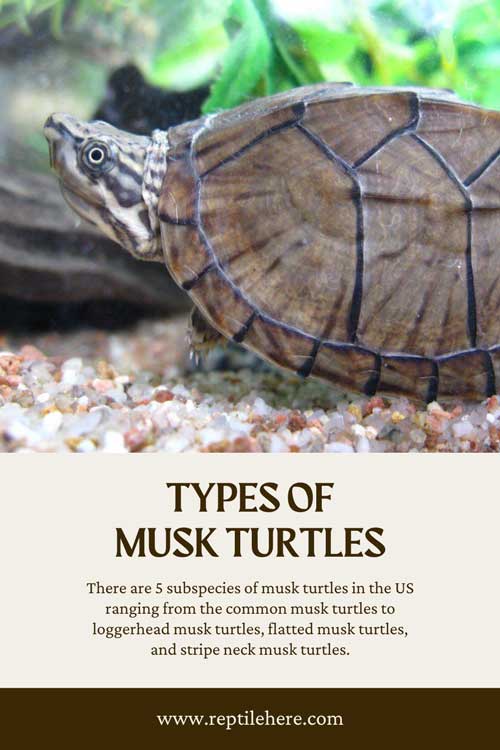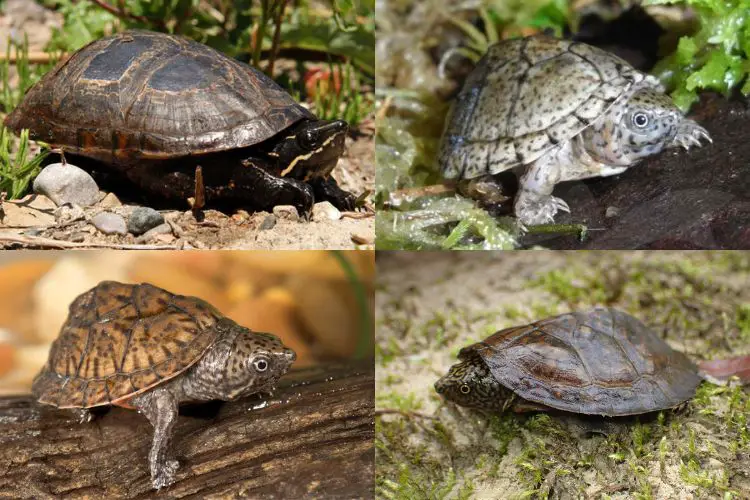Types of Musk Turtles
There are 5 subspecies of musk turtles in the US ranging from the common musk turtles to loggerhead musk turtles, flatted musk turtles, and stripe neck musk turtles.
These moderately small turtles are endemic to North America and are popular for keeping as a pet. They’re called “Musk” turtles because they tend to remove a foul smell whenever they feel threatened.
Unfortunately, the flattened musk turtle is designed as a critically endangered species while the stripe neck turtle is classified as a vulnerable species. This means their populations are on the decline and may become extinct in the near future.
Find below our complete list of all the musk turtles that reside in the United States and the basics you need to know about each of them.
For each turtle, we’ll discuss basics such as physical appearance, average adult size, habitat, diet, and more.
1. Common Musk Turtle
Contents
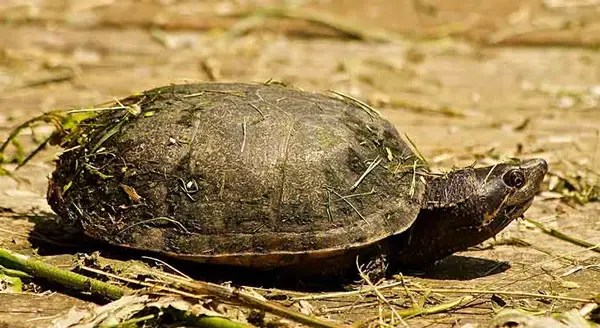
- Scientific name: Sternotherus odoratus
- Common name: Eastern Musk Turtle, Common Musk Turtle, Musk Turtle, Stinkpot
- Family: Kinosternidae
- Size: 2 to 4.5 inches
- Lifespan: 30 to 50 years
- Conservation status: Least Concern
The Common Musk Turtle is usually found in slow-moving and sluggish streams as well as still-water bodies. The turtle prefers areas with dark crevices, where it can easily hide. It also prefers lots of plant matter to burrow in and hide.
An average adult eastern musk turtle is quite small (2 to 4.5 inches long). It has a pretty plain appearance with highly consistent colors. Both the shell and skin usually share the same color and can range from dark brown to black.
The turtle shell has one unique feature—a ridge traversing its entire shell length. Besides, it has another distinctive feature: two light-colored stripes on its head.
Common musk turtles are herbivorous and will eat small aquatic or semi-aquatic animals, carrion, and aquatic vegetation. They will also feed on any other vegetation on land.
When it feels threatened, this turtle species emits a foul odor (a musky odor, hence its name). This scent can be detected in water or on land. It can also easily waft through the air to its predators.
2. Loggerhead musk turtle
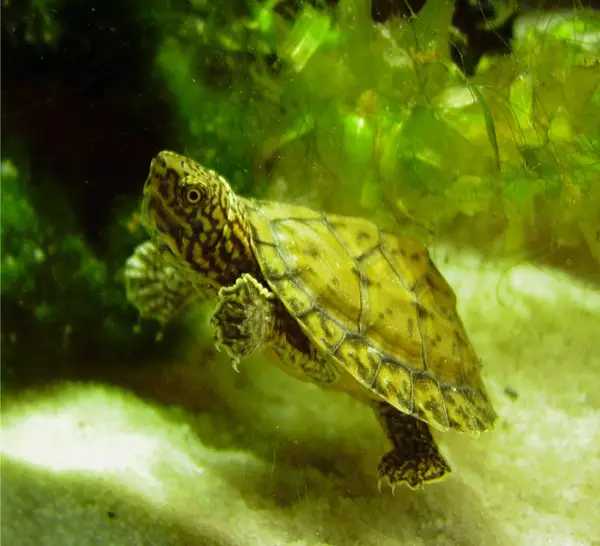
- Scientific name: Sternotherus minor
- Common name: Stripe head or loggerhead turtle
- Family: Kinosternidae
- Size: 3 to 4 inches
- Lifespan: 20 to 40 years
- Conservation status: Least Concern
The loggerhead musk turtle is the most recognizable of all the musk turtles, thanks to its large head and a beak-like mouth that easily set it apart from many other species of turtles.
These turtles are among the smallest of the species in the US, with the adult hitting a maximum length of 3 to 4 inches.
Also, the loggerhead turtle features quite pronounced scutes in the middle of its shell which become less and less visible as it ages.
Their carapace is usually light brown with a small streak of black. And their lower shell side is light brown or yellow. The skin color is black, with light brown lines.
As for the habitat, these turtles prefer streams and springs with muddy bottoms, where they can comfortably and safely rest or lay eggs.
Loggerhead musk turtles are mainly carnivorous and their diet consists of fish, snails, and mollusks. When approached by predators, these turtles will also produce a foul smell.
3. Flattened musk turtle
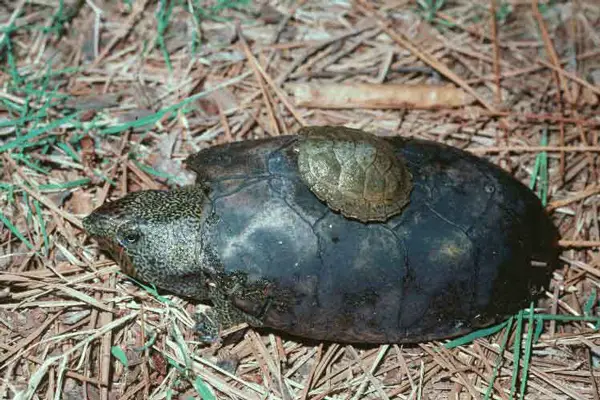
- Scientific name: Sternotherus depressus
- Common name: Musk Turtle
- Family: Kinosternidae
- Size: 3 to 4 inches
- Lifespan: 50 to 60 years
- Conservation status: Critically Endangered
The flattened musk turtle is ONLY found in Alabama. To be more precise, it lives in the Black Warrior river system, located in west-central Alabama.
This turtle species is quite small (3 to 4 inches long) and differs from other turtles with its carapace shape that’s flat on top, with rounded edges. The scutes on its carapace slightly overlap to give the shell a ridged look.
Flattened musk turtles usually have a dark brown carapace while the lower side of the shell is lighter brown. The skin can be black or dark brown, with numerous olive spots.
The musk turtle species love to eat aquatic insects and mollusks and live in freshwater lakes and rivers.
One interesting fact about these turtles is that they’re believed to have evolved over 15 million years ago before the dinosaurs became extinct.
Flattened musk turtles are protected given that 90% of their habitat has been destroyed as a result of erosion caused by strip mining in their habitat.
4. Razor-backed Musk Turtle
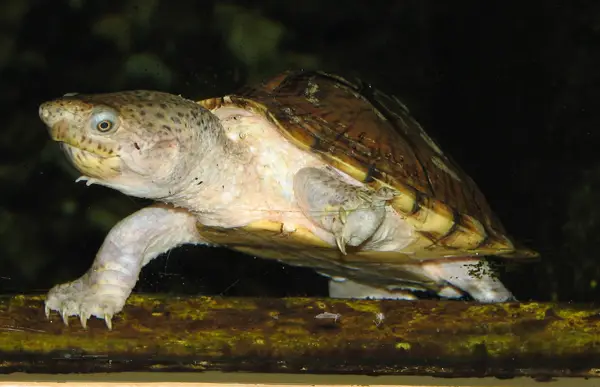
- Scientific name: Sternotherus carinatus
- Common name: Musk turtle, stinkpot
- Family: Kinosternidae
- Size: 5 to 6 inches
- Lifespan: 40 to 50 years
- Conservation status: Least Concern
The razor-backed must turtle is identified by the keels on its back. In other words, its carapace is shaped like a tent that comes to a point along its spine and then slopes down on its sides.
Just like the other must turtles, this species is also pretty small and the average adult hits 5-6 inches in length. Their shell color ranges from light grey to olive, brown, and black.
Skin color can be olive or dark brown, though the exact color differs from individual to individual.
These turtles usually have long necks and large heads which usually have bright colors and turn gray with dark spots as they age.
This razor-back musk turtle prefers living in water almost entirely and will only leave the waters to bask or when it’s time to lay eggs. The species live in deep waters of oxbow lakes and river swamps. They also prefer living in slow-current large streams.
Diet-wise, the razor-back musk turtle is mainly carnivorous and is fond of mollusks, snails, and fish.
5. Stripe Neck Musk Turtle
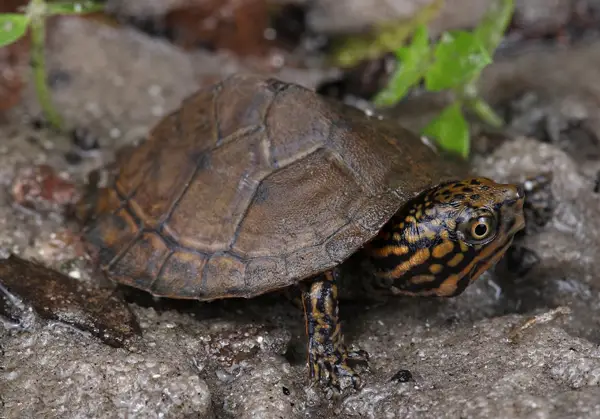
- Scientific name: Sternotherus minor peltifer
- Common name: Stripe-necked Musk Turtle
- Family: Kinosternidae
- Size: 3 to 4.5 inches
- Lifespan: 20 to 50 years
- Conservation status: Vulnerable
The Striped-necked musk turtle is a subspecies of loggerhead musk turtle that lives in Tennessee, North Carolina, and Virginia.
This small aquatic turtle has a larger head compared to other musk turtles. It is highly aquatic and likes living in streams as well as rivers in the mountains.
The most distinguishable feature of this musk turtle is the numerous dark stripes that line its neck and head. its carapace is keeled and gray or brown in color.
The carapace may sometimes feature dark spots or streaks. Its plastron is yellow and unspotted.
In terms of diet, this turtle species is omnivorous but mainly likes eating aquatic insects and small snails. It is diurnal and tends to conduct its foraging in the morning hours.
Conclusion
Now you know all the musk turtle types found in the US. These include the common musk turtle, stripe neck turtle, flattened musk turtle, razor back muck turtle, and loggerhead musk turtle.
The flattened musk turtle and stipe neck musk turtle are the only subspecies of musk turtles that are endangered. the rest have the least concern status, meaning their population isn’t under threat.
As you can see from the above list, these musk turtles are moderately small which makes them an ideal choice for pet turtles.
Plus, they’re also easy to care for, further making them a favorite among many turtle owners.
